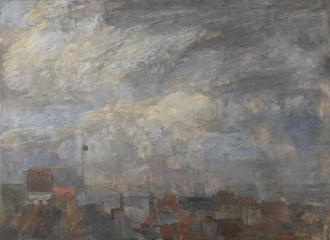This archived website ‘James Ensor. An online museum.’ is temporarily not being updated. Certain functionality (e.g. specific searches in the collection) may no longer be available. News updates about James Ensor will appear on vlaamsekunstcollectie.be. Questions about this website? Please contact us at info@vlaamsekunstcollectie.be.
Dreams of mother-of-pearl
The Ensor Collection of KMSKA in Ostend
James Ensor is known worldwide. Museums, collectors and enthusiasts from all over the world are fascinated by his groundbreaking art. Long before the term became a fashionable cliché, Ensor was certainly a game changer. But all too often, the artworks themselves are overshadowed by the popular myth: that of a strange, misanthropic eccentric who sat behind his piano in his Ostend shell shop.
The innovative nature of Ensor's paintings, etchings and drawings is the direct result of his desire to explore, in an almost systematic way, the most diverse techniques, genres and modes of representation. In a letter to the art critic Pol De Mont, written as early as 1894, he said: "j'ai étudié attentivement les manières les plus opposées" (I have attentively studied the most diverse artistic styles). And he defended his pursuit of artistic diversity, and the search for various stylistic, iconographic or technical alternatives, until advanced old age. Only in this way could an artist succeed in transporting his audience, and that was the ultimate goal for Ensor. He was captivated by the elation that he felt whenever he took his Brussels friends to the promenade and showed them the miraculous beauty of the sea. This was the bliss of which he dreamed when, inspired by the pearly interior of a shell, he painted his religious tableaux, landscapes or still lifes.
In order to do justice to both the immense diversity and underlying artistic coherence of his oeuvre, Ensor's works will be shown in three thematic ensembles:
(1) Landscapes and fantastic compositions in which the artist searches for sublime images. Quasi-abstract evocations of the luminous mists above the sea, the teeming chaos of The Fall of the Rebellious Angels who do battle with the elements, the childlike, fairy-tale procession of a brass band through the streets of Ostend, the spectacular Expulsion of Adam and Eve from the Earthly Paradise, and the mysterious silence over the roofs of the houses in Ostend.
(2) Inspired by Maeterlinck and Jan van Ruusbroec, Ensor described colour as "the ornament of our spiritual wedding". In his view, the still life was the touchstone of the true colourist. From 1880 to 1941, Ensor painted around 700 canvases, more than a third of which are still lifes. For Ensor's friend, the poet-critic Emile Verhaeren, even The Oyster Easter (1882) was first and foremost a monumental still life. This painting is therefore central to the ensemble of still lifes painted between 1880 and the 1930s.
(3) Ensor's contemporaries considered his depictions of young bourgeois women in interiors (The Oyster Easter, The Bourgeois Salon, Afternoon in Ostend) as a tribute to the intimate charm and domesticity of their world. But ‘the woman' is also the protagonist in grotesque masquerades such as The Astonishment of the Mask Wouse (1889) or Skeletons Fighting for the Body of a Hanged Man (1891).
The Ensor Research Project
In 2013, the Royal Museum of Fine Arts in Antwerp (KMSKA) launched the Ensor Research Project (ERP), whereby the master's paintings are studied using advanced imaging techniques (infrared reflectography, X-ray, Portable X-Ray Reflectography, etc.). The ERP team has recently been expanded to include members of staff from Mu. ZEE. Until now, the investigations have focused on the collections of paintings belonging to the KMSKA, Mu. ZEE, the Museum of Fine Arts in Ghent (MSK) and a private collection. The first interim results of this research will be incorporated into the new Ensor presentation.
The new Ensor presentation consists almost exclusively of paintings and drawings from the collection of the Royal Museum of Fine Arts in Antwerp. With 38 paintings and some 650 drawings to its name, the museum boasts not only the largest but also the very finest Ensor collection. Directly and indirectly, these holdings are the fruit of the dedication shown by Antwerp collectors such as François Franck, Albin and Emma Lambotte, and the art-loving members of the exhibition association known as Kunst van Heden (1905-1955). But head curator Walther Vanbeselaere (1948-73) also played a decisive and important role in determining the quality of the Antwerp Ensor collection. The fact that the Antwerp museum has developed into the leading centre of expertise on Ensor is also down to Vanbeselaere.
In recent years the Antwerp Ensor collection has been exhibited in New York, Chicago, Los Angeles, Tokyo, Basel, Copenhagen and Utrecht. The KMSKA is placing 26 paintings on long-term loan to Mu. ZEE. In addition, ensembles of drawings will be shown in a series of changing displays.
Exhibition Dreams of Mother-of-Pearl
As of May 13th through June 16th, 2018
Mu.ZEE, Ostend
(News Item May 5th, 2018)







